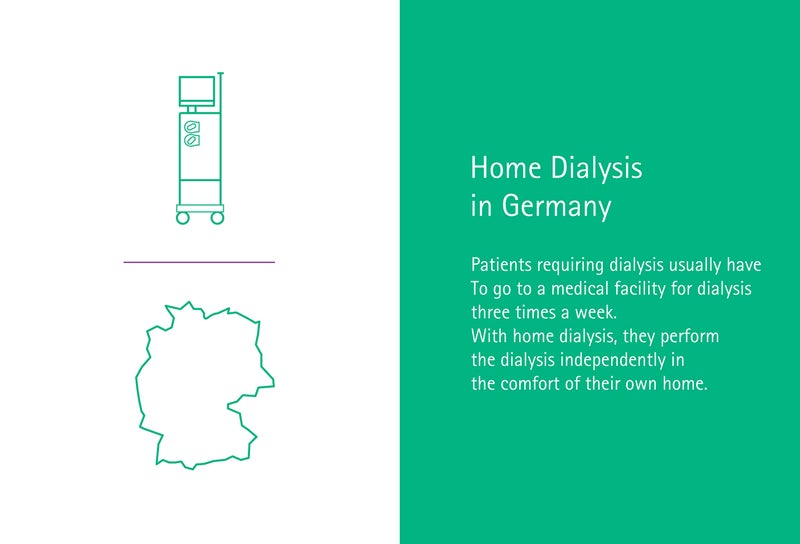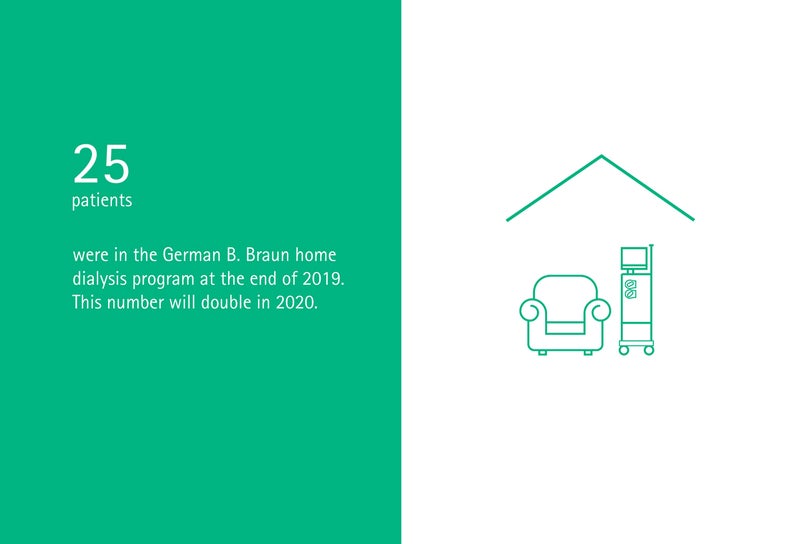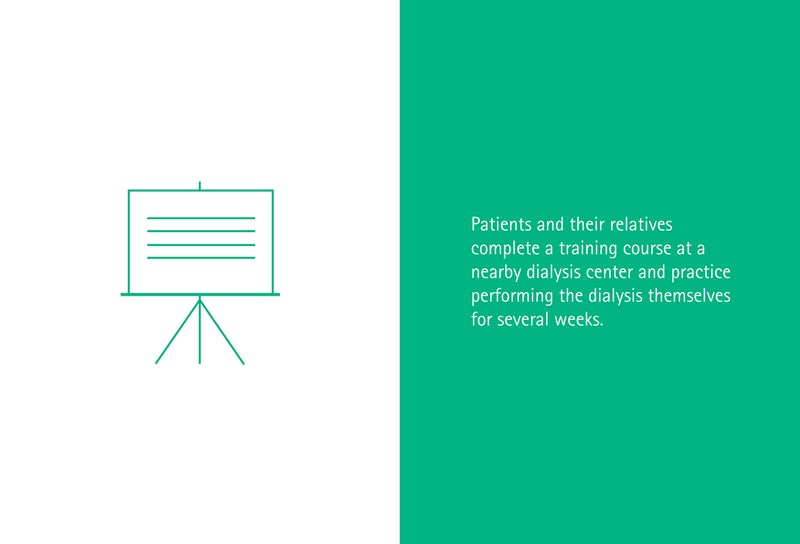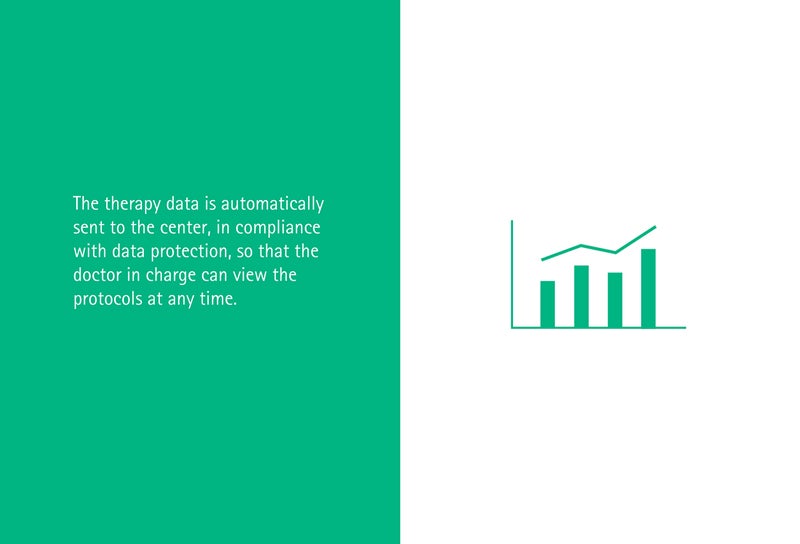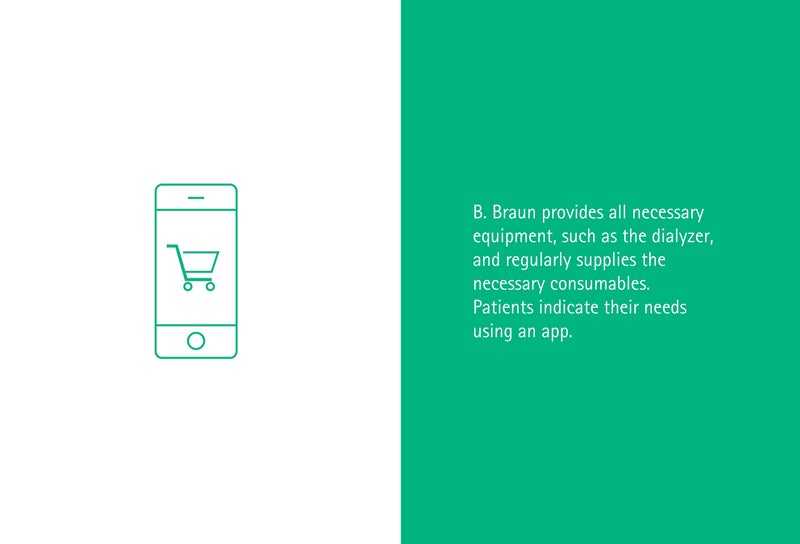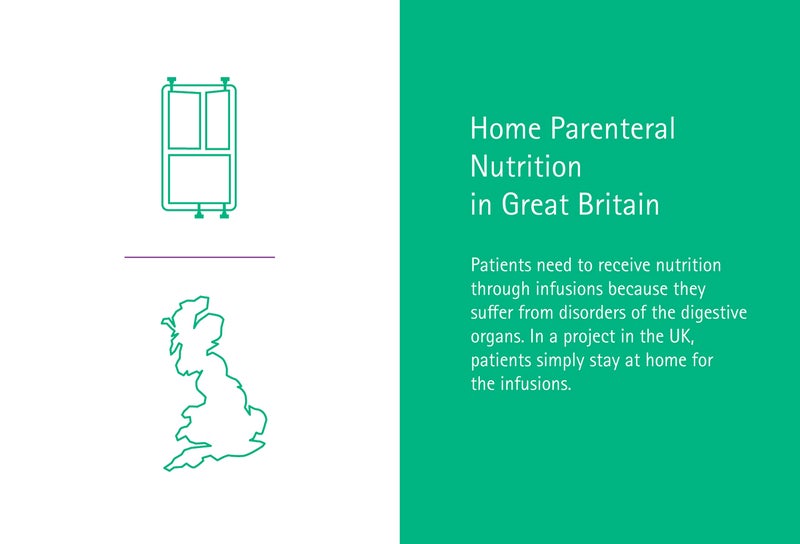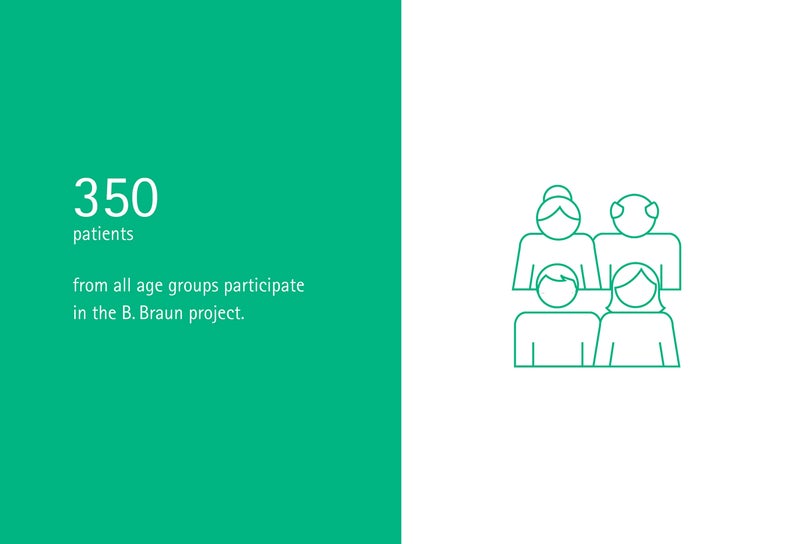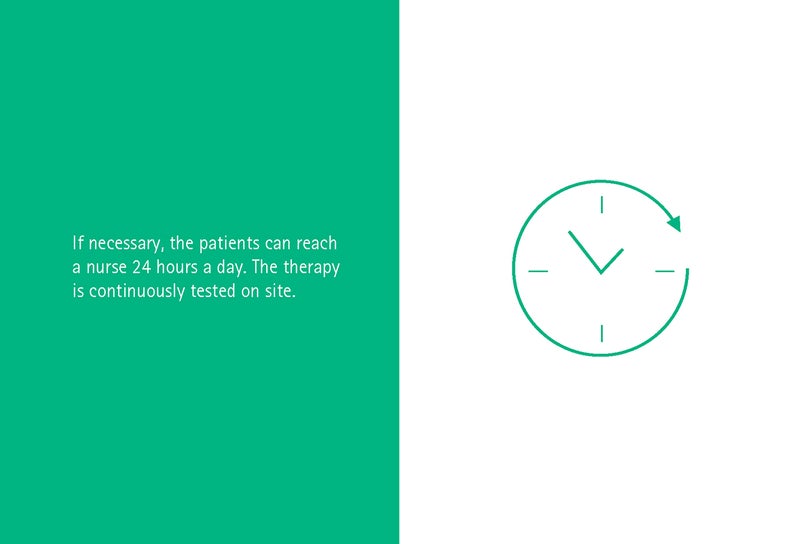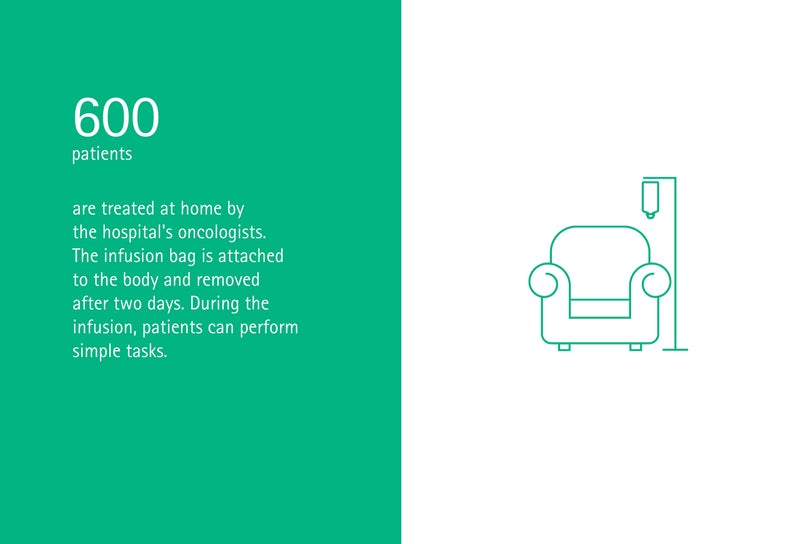New Freedom
More and more people are taking care of themselves at home, with therapies that used to involve intensive hospital stays. Many patients are regaining control over their lives – while also saving health system resources.
Therapies at home: faster recovery?
Claudia and Matthias Hatscher have a special hobby: the married couple in their forties loves Marvel films. They used to go to the movies frequently together to watch "Iron Man" or "The Incredible Hulk". They also visited Cologne’s gaming convention Gamescom every year. Starting in 2018, this became almost impossible.
After a heart attack, and due to various pre-existing conditions, Matthias’s kidneys grew weak. A kidney transplant failed, and he needed dialysis. “Before something like this happens, you just can’t imagine what it means,” says Claudia Hatscher. More than anything, dialysis means lost time. Patients must visit a dialysis center at least three times a week – and they are not able to choose their appointments. Once there, patients must wait four to six hours before the machines have cleansed their blood of toxic substances. In healthy people, this is a process that is handled by the kidneys. If dialysis patients must work for a living, their life consists solely of dialysis and work. “And traveling back and forth,” adds Claudia Hatscher. “A normal family life was no longer possible. Our three children had just entered adulthood, and we actually wanted to have more time for us again.” Instead, last year, the couple from Baesweiler were running on empty.
But then the Hatschers heard about the possibility of using dialysis at home and got in touch with B. Braun. A medical team handled the apartment modifications for the equipment, while the Hatschers participated in intensive training courses over several weeks. Matthias Hatscher now purifies his blood at home, with help from his wife and a mobile team of caregivers – in a room rebuilt specifically for this purpose.
„The key to successful treatment at home is the fact that the patients are not alone. Having family or friends to help out and competent caregivers to monitor the treatment is crucial.“
B. Braun: safe & high-quality home therapies
Nowadays, more and more therapies are developed to the point that patients can administer them themselves, with assistance from competent professionals. B. Braun is developing various programs to support this trend and offer safe, high-quality home therapy. These include a program for chemotherapy at home in Thailand, at-home stoma care in Ireland, home parenteral nutrition in Great Britain and home dialysis in Germany.
Treating people at home in their living rooms, instead of at the hospital, is an approach that improves quality of life for many patients. “People with severe or chronic diseases often suffer from depression and anxiety. They have the feeling that they are powerless and have little control over their life,” says Heike Spaderna, Professor for Health Psychology at the University of Trier. Being able to choose the treatment time and having more time for yourself and your family makes a big difference in terms of mental health.
“The key to success, however, is the fact that the patients are not alone. Having family or friends to help out and competent caregivers to monitor the treatment is crucial,” emphasizes the health psychologist. If these conditions are in place, treatment at home is an enormous psychological advantage.
Claudia and Matthias Hatscher order all the necessary materials using a special app. They receive regular visits from the B. Braun Home Service for equipment maintenance and support. Their dialysis machine is connected to the internet and it transmits all the vital data, such as the patient’s weight or blood pressure, to the doctors at the dialysis center. If there are any problems or discrepancies, the Hatschers can call their dialysis trainer at B. Braun. If this person is not available, a B. Braun service hotline provides round-the-clock reliability. Matthias drives to the dialysis center near Erftstadt (in the Cologne region) only once a month for a checkup.
„Home dialysis has major advantages, even from a medical perspective. People who receive their treatment at home are healthier and have better results than patients in dialysis centers.“
But is treatment at home just as effective and safe as it is in a hospital? Some patients fear they will only receive second-rate treatment at home. This couldn’t be farther from the truth, as the experiences reported from all these home-treatment projects are encouraging. “Home dialysis has major advantages, also from a medical perspective. People who receive their treatment at home are healthier and have better results than patients in dialysis centers,” reports Simone Klein, head of the Home Hemodialysis Service in Germany. The reason for this is clear: in the dialysis center, patients are dialyzed three times a week. As a result, toxins collect in the blood and the patient’s condition worsens, especially during the long break over the weekend. “At home, patients can undergo dialysis more often or for a longer period, which eliminates the pause in treatment on the weekends. They can easily integrate dialysis into their daily lives. More time for dialysis and less stress during the procedure is also easier on the body and does not wear the patient out as much.” The majority of dialysis patients are no longer able to work. Their bodies are too exhausted from the dialysis procedure, which often must be carried out as quickly as possible. Matthias Hatscher has been able to continue with his job. He works full-time as a business clerk.
„Patients who are supported by us at home and give themselves infusions not only have a better quality of life, but they are also less likely to have a relapse of their respective condition and suffer from complications, and they recover quicker overall.”“
When patients require parenteral nutrition, they also recover better at home than in a hospital. People who rely on this form of nutrition suffer from digestive system diseases, such as intestinal obstruction or esophageal cancer. They must be fed intravenously because their digestive system can no longer perform this task – for some, this may be a life-long treatment. “Patients who are supported by us at home and give themselves infusions not only have a better quality of life, but they are also less likely to have a relapse of their respective condition and suffer from complications, and they recover quicker overall,” reports Zbigniew Zapalowski, who manages the B. Braun project for home parenteral nutrition in Sheffield, Great Britain. Compared with patients in hospitals, home care patients also demonstrated better compliance. This means that they are better prepared to keep up with treatment and, for example, they are less likely to voluntarily stop taking their medication. “The patients who have to cope with such an unpleasant procedure for life are incredibly happy if they can lead as normal a life as possible,” stresses Zapalowski.
Better use of hospital ressources
In addition to the better quality of life for patients, home therapies have another advantage: they save resources so they can be distributed to the right places. This is particularly noticeable in the cancer treatment project in Thailand. The doctors at Bangkok’s Ramathibodi Hospital have been treating some of their cancer patients at home for a few years and they benefit from the experience and infrastructure provided by B. Braun. Patients are not forced to lie in a hospital bed for weeks for the chemotherapy, as is otherwise still common in Thailand. “Unfortunately, Thailand is also experiencing a drastic rise in cancer cases,” says Phichai Chansriwong, head of the Oncology Department. The hospital’s doctors currently treat around 1,000 cases a year. “On average, 300 more people would actually require chemotherapy.” However, the hospital cannot yet provide more beds and personnel. Doctors have had to send some patients home without treatment.
Hospital treatment is expensive, and personnel costs are high. For the Ramathibodi Hospital, there had to be a solution that guaranteed good, affordable treatment and saved resources. Health care systems in western industrialized nations, such as the USA and Germany, solve the problem by making treatment more efficient: in Germany, for example, the average length of hospital stays shrunk from around 13 days in 1992 to about seven days in 2018. When possible, patients return home as soon as they are able and then receive further outpatient care. This is a better use of resources and, in many cases, an early discharge is a health benefit for patients, as studies show. Three years ago, Chansriwong and hospital director Surasak Leelaudomlipi started the new home care program in the Oncology Department: patients obtain the doses of the medication they need at the hospital or from a pharmacy and then return home. In some cases, they even receive the medication at home. Specially trained nurses, who can be reached via app or telephone at any time, are available to help with questions and problems. Before treatment begins, family caregivers must complete a short training course at the hospital.
Around 600 of the large hospital’s patients are currently receiving some degree of treatment at home. “Since the project began, we have been asking patients about their quality of life, and we have compared the treatment results with those from patients who remain in the hospital,” reports Chansriwong. The home care patients indicate a higher level of satisfaction, and the treatment results are just as good as those for inpatients. “For patients with a terminal illness, treatment at home even extends their life by a few months, on average.” In addition, due to the cost and space savings, more people are able to get the appropriate medical care. More hospital beds are available to patients who desperately need them. The experience has been so positive that hospital director Leelaudomlipi has much more in store: “Our goal is to first implement the program in a neighboring hospital and then nationwide.”
This dilemma has also manifested itself in Germany: health care staff is scarce and hospitals are under considerable cost pressure – nevertheless, patients need treatment that is both safe and effective. Home therapies can help to ensure this for patients. For dialysis patient Matthias Hatscher and his wife, for example. “We have our life back now,” says Claudia Hatscher. “And tomorrow we are going to the movies.”


